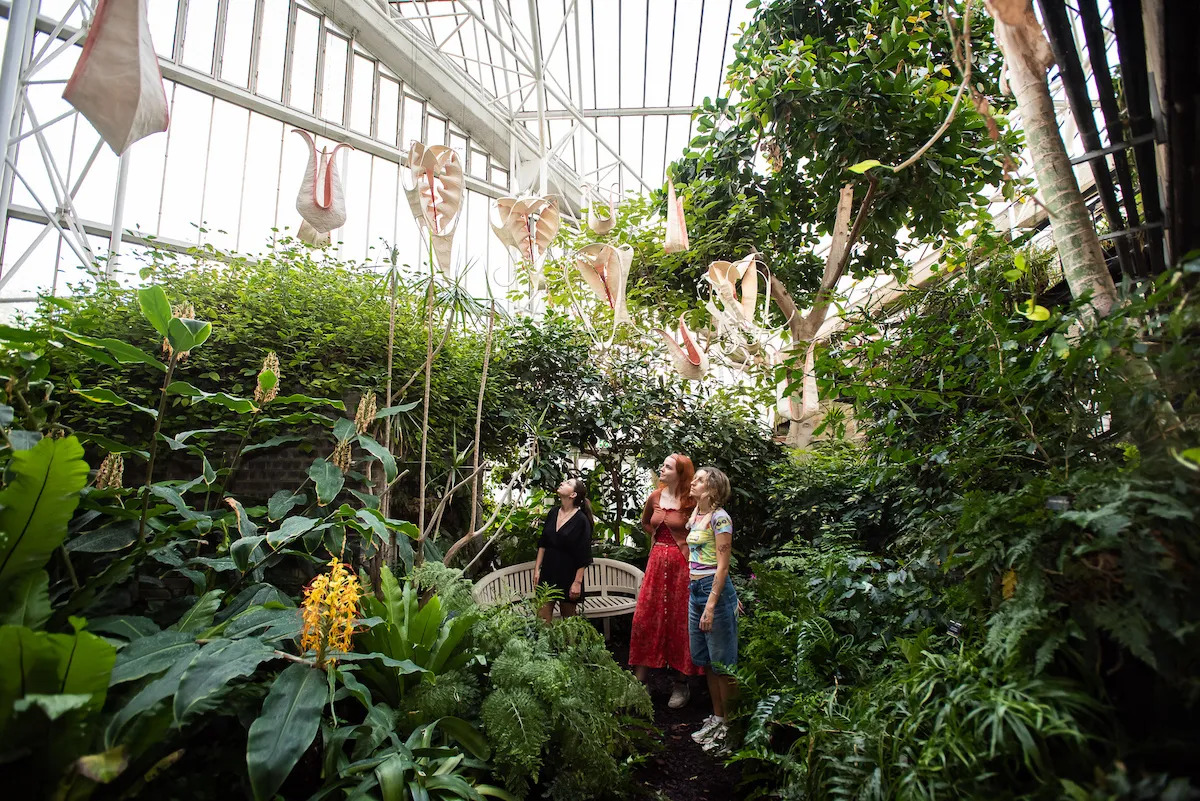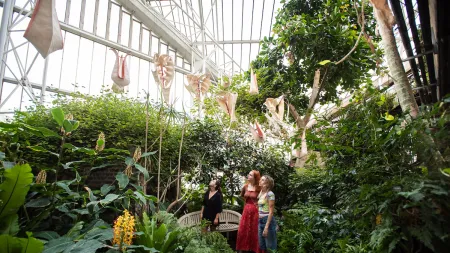
The brutalist maze of the Barbican Estate in London, a huge concrete complex with 2,000 apartments, an arts center, and a conference hall, is an unlikely setting for whimsical art. But hidden away inside this modernist icon is one of London’s best kept secrets: a lush, green rainforest, with over 1,500 tropical plants.
This is the Barbican Conservatory, where Indian sculptor Ranjani Shettar is having her first major institutional show in Europe. It’s also the Barbican Conservatory’s first site-specific work, commissioned specially to work with the intriguing possibilities offered by the 23,000-square-foot space.
The exhibition is titled “Cloud Songs on the Horizon,” but in an interview, Shettar declined to explain the name, saying that she “prefers visitors to arrive at their own interpretations.” There are five groups of suspended sculptures, each molded out of stainless steel and covered with fine, translucent muslin. Some of the sculptures are accented with lacquer. Others are dyed with madder root and pomegranate dye.
The mirrored surfaces of these steel forms create the sense that there are fantastical leaves, vines, curlicues, daisies, flowers, and clouds held within the conservatory. One zany group of sculptures, appropriately called “Moon Dancers,” gyrates like exotic birds over a pond filled with plump koi fish. The contrast between Shettar’s soft shapes and the Barbican’s strong concrete works, somehow.
The sculptures seem to have sprung out of the ground, but that effect was incredibly challenging to achieve for Shettar, because the site kept shifting. So far, she has only exhibited against the plain white, static walls of galleries.
“I came to the Barbican in December to look at the site, then went back to work in my studio in India,” she said. “But the light kept changing with the weather, the plants kept growing, the surroundings kept moving. I had to design for an everchanging venue.” Despite the difficulty of the site, Shettar was given just six months to produce her sculptures.
Shettar is from the southern Indian city of Bangalore, now Bengaluru, known for its tech industry. Growing up in the 1990s during the city’s tech boom, she was surrounded by engineers. Indeed, as is the case with many Bangaloreans, her entire family includes many engineers. The slightly built, bespectacled Shettar says she is often mistaken for one herself when going through immigration at Heathrow Airport. When she was a kid, middle-class Indians did not become artists, but her dad was encouraging. “He lit my path for me; he knew I would be happier as an artist.”
She studied art at the Bengaluru-based university Chitrakala Parishath, where, she said, she began giving herself permission to “not follow the rules.” At the time, the Indian painter M.F Hussain, with his paintings of horses, elephants and goddesses, had great influence.

“What was expected of me was figurative,” Shettar said, “something on a pedestal. But I was always going off track, doing things not expected of me.” She continued to defy convention when on graduating, instead of moving to New Delhi or even staying in Bengaluru, she and her sculptor husband moved to a small town in the southern Indian state of Karnataka, surrounded by the Sahyadri mountain range. As Bengaluru grew stratospherically, the couple retreated to a house they built on their own, with a zero-waste studio for Shettar. “I needed space,” she said. “And not everyone should be moving to big cities. There has to be some reverse migration.” It rains so much in her town that industry has luckily been deterred from entering. “I am surrounded by small farmers and greenery,” she said. The town is also known for sandalwood carvers and traditional crafts.
Shettar’s rural location has influenced her work, which remains organic, with a deep connection to nature. Her sprawling sculptures use traditional Indian crafts and materials, like tamarind and indigo dyes, lacquer, beeswax, and reclaimed teak wood. These materials are then mixed with industrial ones like steel wire and washers, to evoke trees, cobwebs, beehives, stars, ponds and other natural themes.
“Cloud Songs on the Horizon,” the Barbican show, is more joyful than any of her past work. Her previous installations, designed to be shown in galleries, were often severe and minimalist. These sculptures, intended for a softer space, are playful. Asked about this, she responded, “Times are hard, and we need something hopeful.” The Barbican’s newly appointed head of visual arts, Shanay Jhaveri, said he chose her because of her “deep embodiment of an ecological consciousness, all emanating from a local context.”
The Barbican work comes as recognition for Shettar continues to grow. Her work now sells for over $100,000, but when she began, there was no money in sculpture, except for the chosen few. “When my husband and I started out, we decided that we would do anything to make sculpture,” she explained. Now, her work appears internationally, in venues ranging from the San Francisco Museum of Modern Art to the Sharjah Biennial. “If someone had asked me to dream, I don’t think I could have dreamt this.”

Despite getting busier, she does not employ a team to help her. “Process is sacred, and integral to me. If I don’t do it on my own, then what am I doing? That’s the fun of it.” Indeed, as she walked around, she pointed out the tiny grooves on the underside of her sculpture, and delightedly took a video of how the light played on them.
In a recent interview with the Financial Times, Shettar called herself apolitical “in a sense.” But a time may come when Indian artists may not have that luxury. Shettar’s work at the Barbican is supported by the Kiran Nadar Museum of Art (KNA), India’s top private museum, which was recently roiled by controversy. A researcher there was fired for criticizing the institution’s namesake collector for mounting what he called a “self-aggrandizing exercise” by the BJP government, which has been criticized for putting forward a Hindu nationalist agenda, and many looked on as an institution that had rarely staged activist programming was suddenly politicized.
Shettar said she didn’t feel compelled to move her art in a more political direction. Asked if artists should today be more like activists, Shettar said, “I do not think it should be a compulsion. I have chosen to keep my art apart from my activism. I engage with society in my own way, and the two do not have to come in the way of each other.”
“I don’t want my art to be preachy,” she continued. “It needs to be aesthetic above everything else. I am not trying to use my art to inform or educate. I work to please myself first.”
Valencia’s Centro de Arte Hortensia Herrero Opens After a Stunning $42 M. Revamp Housing 100 Works by International Artists
Chile’s Venice Biennale Pavilion Faces a Troubled Selection Process, Resulting in Resignations

Porter Road’s Black Friday Sale Gives You 20% Off the Choicest Cuts of Beef, Poultry, and Pork

Lacoste Tails Off Anniversary Year With Lemarié and The Sandbox Collaborations

I can’t believe Apple AirTags are this cheap for Black Friday

Why Jets-Dolphins NFL Black Friday Game Is Such a Rarity


